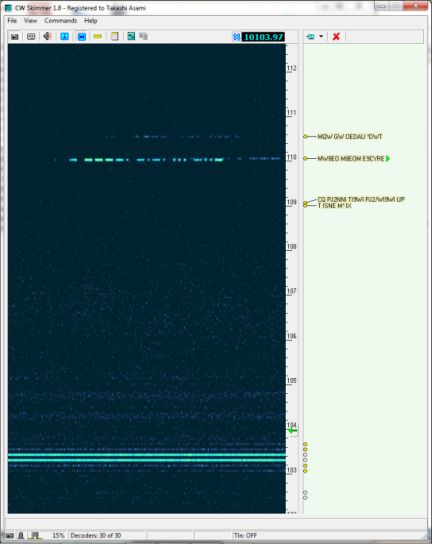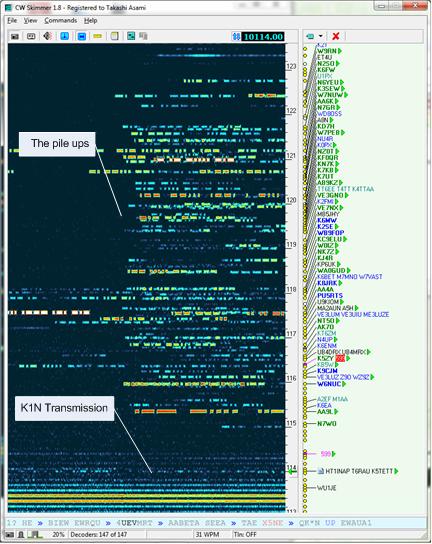W6SI Blog Page (Entry 4)
3/9/2015
Thank you, K1N… It was a Blast!
Navassa Island DX Pedition. We all heard about it, we all wanted to score. But the island is turned on after three decades of absence. The competition would be fierce.
That’s how I saw on the evening of February 4, the first day K1N is expected on the air.
Checked out on 20 meter CW band. Wow! I am scanning the band using CW skimmer, and the whole band is literally lighted up. See the picture. This is the actual view of 30 meter band one evening while K1N is on. The tiny thin line at the bottom is K1N’s transmission. Every line above is the stations calling him. To give you a reference, I’m also showing you how the band looks like when K1N is NOT around below.
IMHO, there was a certain level of letdown after the big ARRL centennial celebration last year, but this one was sure to light up the sky again.
Navassa Island is in Bahamas, right off the coast of Haiti (which is in territorial dispute of the guano island with the U.S.). It is not that far distance, should be easy to get, was my pre-QRV impression. Their website http://navassdx.com even had a link to propagation estimate by K6TU. The site generates a nice propagation chart, sorted by band, from my QTH. Armed with this, how can I go wrong?
But their signal was not as strong as I hoped. That is not a good news, when I’m only 100 Watt and vertical (Yes, it is my mighty MV Special vertical (see the description on this web site), and performing flawlessly, but it’s no big beam on a high tower).
Knowing K1N is on a beam or a vertical by the water, with 500 Watt, if they are S3 to 5 that I’m hearing, I must be S1 to 3 to them. Not good in terms of competition. Most of those guys calling him are big guns. And many are in W4 and W5 wall, blocking the West Coast beach boys.
When trying to score a DX station, there are two trains of thought. You carefully observe the station he makes contact, and quickly QSY to his frequency and call the DX there, before he moves on. Well, with that many stations on the air, it is very hard to spot who he actually made contact with, most of the time.
Another line of thought is that you aim at the frequency range where no one is making a call, in the hope that DX station will give up managing the pile and escapes to more sparse area. This can work sometimes, but not very often. But if most everyone else’s signal is estimated to be stronger than mine, then that might be the only hope. So I went. Hour after hour hanging tough in there, hoping to hear back my call sign.
By the way, in case you are new to this, it is almost always true that DX communications are done in a split frequency. You never call the DX on his transmission frequency. The station typically sends “CQ CQ DE K1N UP UP”. Unfortunately, several people did not understand “UP” and keep calling on the frequency. This can be pretty embarrassing because unlike DQRM (meaning Deliberate QRM – those folks who gets some kind of satisfaction by transmitting full power carrier wave or repeated dits on DX station’s frequency, annoying everyone), you are advertising your own call sign for everyone to hear. We don’t do such thing, do we?

When K1N is NOT present... this is how 30 meter band looks like.

Anyway, according to navassadx.com blog, the pileup started immediately when they got on the air, and continued to be fierce throughout, never let down, for the total of 120,000+ contacts. This is great for them, but it was not working for me. On the first day, I saw the band totally boiling over, and after several hours of trying, I never got a call back. So I said, “Oh, well, give it a rest for a day, and it’ll slow down…” No it didn’t. It kept going on and on. I did not QRV on a couple of nights since, due to some domestic business, and now there is only a single digit days left. OK. Let’s work this out in the weekend.
But on the weekend of February 8, there were darn content going on. Not just one. Two. FOC (First Class Operators’ Club) contest, which is supposed to be a closed club (invitation only, for the “first class rated operators” only) competition that clobbered the bands in a big way. And that was followed by North American CW Sprint contest. Neither is a major contest, but enough to fill up the band with strong signals, making it very hard to locate K1N. I suppose they could not reschedule the contest to avoid this 12 days period K1N is on the air after 30 year absence?
But the break finally came on Saturday night (almost Sunday morning), on 40 meter band when after so many hundred times calling them, I suddenly hear “W6SI 5NN…” Wow. Is it for real? I didn’t know how to deal with it for a second, but managed to send “R R UR 5NN 5NN TU”. 5NN? No, he was more like 55N. But I must have been even weaker. Still, somehow managed to cut through the pileups. Call it luck. That happens once in a while. So that’s it? After the long persistent calling, it’s just that. The sense of relief was enormous.
Sunday morning, I could hear them on 12 meter band, but weak (S1~2). I tried to get them but no. I had to go somewhere, so that was that.
When I came back late afternoon, the 20meter band was happening. K1N was strong. So were everyone else, though. I was aiming at the top end of the “swarm”, and keep persistent there. That was about 5.5KHz above their calling frequency.
Then I detected the change of operator (After 10 minutes QRX, CW speed went up from 35WPM to 40+), and he sent “CQ de K1N UP 2”. So I quickly adjusted my XIT down to 2.0 and called him. The first shot. I got him. That “W6SI 5NN”. What a beautiful sound.
So I got on their log on two bands (40m and 20m, both CW). I was still trying to get them on 30meter, but that proved to be tough. I never could get it. Oh well.
BTW, I am using KX3 and KXPA100 combo and my home made vertical. With such a modest set up, trying to compete with SSB is tough. Also it would not be popular with the family if I kept yelling at microphone at late night. So I focused on CW. If you would like to work some DX around here, it is highly recommended, at least it’ll give you a good fighting chance. And don’t need to know a whole lot about copying Morse code. Just need to get a call sigh (in case of K1N, we already knew his call sign, so you only need to recognize your own call sign when called).
Well, that fortnight of excitement came and gone. What a blast. Since W1AW portable station got off the air at the end of last year, I haven’t had a good target to shoot at. This one will quench my thirst for a while.
Above is a reflection of my thought and only mine. But if you have any questions, feedback and/or suggestions, please send me an e-mail. I might reply on this page (sorry, no guarantee)
